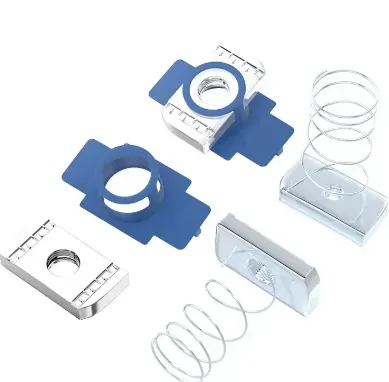

Photovoltaic bracket: The key support for the stable operation of photovoltaic power generation systems
Май . 19, 2025 14:01 Обратно к списку
Photovoltaic bracket: The key support for the stable operation of photovoltaic power generation systems
As an indispensable component of photovoltaic power generation systems, фотоэлектрические кронштейны not only support photovoltaic modules, but also serve as the foundation for ensuring the long-term stable operation of the entire system. The quality, design, and installation of фотоэлектрические кронштейны directly affect the safety, reliability, and power generation efficiency of photovoltaic power generation systems. Therefore, in-depth understanding and research on photovoltaic brackets are of great significance for promoting the healthy development of the photovoltaic industry.

The main function of photovoltaic brackets is to provide stable support for photovoltaic modules, enabling them to be exposed to various environmental factors for a long time
The комплекты для монтажа солнечных панелей на крышу must be able to withstand the pressure brought by these extreme weather, whether it is exposed to the sun, storm, or snow. Therefore, there are extremely high requirements for the material selection of photovoltaic brackets. Common materials include steel, aluminum alloys, etc. These materials need to have good corrosion resistance, tensile strength, and compressive strength to ensure that the bracket can maintain its structural integrity and stability in various environments. In addition, the geographical environment and climate conditions vary greatly in different regions, and suitable materials and design schemes need to be selected according to the specific local conditions. For example, in coastal areas where salt spray corrosion is severe, it is necessary to use materials with stronger corrosion resistance.
The design of photovoltaic brackets is directly related to the power generation efficiency of photovoltaic modules
On the one hand, the design of Кронштейны для фотоэлектрических панелей requires the ability to adjust the tilt and azimuth angles of photovoltaic modules to maximize their ability to receive solar radiation, thereby increasing power generation. On the other hand, the design of the bracket also needs to consider the issue of obstruction, and try to avoid the bracket itself or surrounding buildings from causing shadow obstruction to the photovoltaic modules, which will affect the power generation efficiency. Therefore, using professional photovoltaic bracket design software for simulation and optimization can effectively improve the power generation efficiency of photovoltaic power generation systems. In addition, some new photovoltaic brackets, such as tracking brackets, can automatically adjust the angle of photovoltaic modules according to the trajectory of the sun, thereby significantly increasing power generation.
The installation quality of photovoltaic brackets directly affects the safety and reliability of photovoltaic power generation systems
During the installation process, it is necessary to strictly follow the relevant specifications and standards to ensure that the connection of the bracket is firm and reliable, and to avoid deformation, tilting, or even collapse of the bracket due to improper installation. In addition, it is necessary to properly handle the grounding of the bracket to prevent damage to the photovoltaic modules caused by accidents such as lightning strikes. Regular inspection and maintenance are also important means to ensure the long-term stable operation of кронштейны для солнечных фотоэлектрических систем.
In summary, photovoltaic brackets, as an important component of photovoltaic power generation systems, play a crucial role in ensuring system safety and improving power generation efficiency. With the continuous development of photovoltaic technology, the requirements for photovoltaic brackets are also increasing. The future photovoltaic brackets will be more lightweight, intelligent, and sustainable. Through continuous technological innovation and optimization, photovoltaic brackets will be able to better meet the needs of photovoltaic power generation systems and make greater contributions to the development of clean energy.
Photovoltaic Bracket FAQs
What are the main functions of a photovoltaic bracket?
Photovoltaic bracket is the supporting structure of solar panels, with core functions including:
Fixed photovoltaic modules: Ensure stable installation of the panel at the set angle and orientation.
Wind and snow resistance: Resist extreme weather conditions (such as 30m/s wind speed or 1.5kN/m ² snow pressure) through structural design.
Adjustment angle: Some brackets come with adjustable tilt angles (such as 15 ° 60 °) to optimize light absorption efficiency.
Photovoltaic bracket: What is the difference between ground bracket and roof bracket?
Ground support: using heavy-duty foundations (concrete piles/spiral ground piles), adjustable inclination angle, suitable for large power stations, with high cost.
Roof bracket: Lightweight design (aluminum alloy/stainless steel), suitable for roof structure (flat roof/sloping roof), easy to install but with limited load-bearing capacity.
What are the common materials for photovoltaic brackets? How to choose?
Aluminum alloy: lightweight and corrosion-resistant (coastal/high humidity environment), but with low strength, suitable for rooftop projects.
Galvanized steel: High strength and low cost (mainstream choice for ground power stations), but attention should be paid to the coating thickness (≥ 80 μ m).
Stainless steel: high corrosion resistance, used in extreme environments (such as near chemical factories), expensive.
Why does photovoltaic bracket need anti-corrosion treatment? What are the common methods?
Long term exposure outdoors can easily lead to corrosion, and anti-corrosion measures include:
Hot dip galvanizing (steel bracket): Zinc layer thickness ≥ 65 μ m, service life of more than 25 years.
Anodizing (aluminum alloy): forms an oxide film, enhances weather resistance.
Dacromet coating: No risk of hydrogen embrittlement, suitable for complex components.
How to evaluate the structural stability of the photovoltaic bracket system?
Three key verifications are required:
Static analysis: Simulate deformation under constant load (self weight+snow load).
Dynamic analysis: testing fatigue resistance under wind/earthquake conditions.
Basic verification: Ensure that the ground piles/compression blocks meet the requirements for pull-out resistance (such as single pile ≥ 5kN).
Последние новости
-
The Versatility of Threaded Rods for Your Projects
НовостиJun.11,2025
-
The Quality Hex Head Self Tapping Screws for Every Project
НовостиJun.11,2025
-
The Essential Fasteners for Every Project
НовостиJun.11,2025
-
High-Quality Flange Nuts for Your Next Project
НовостиJun.11,2025
-
Explore the Versatility of T Bolts for Your Projects
НовостиJun.11,2025
-
Explore the Best Slotted Channels for Your Projects
НовостиJun.11,2025

